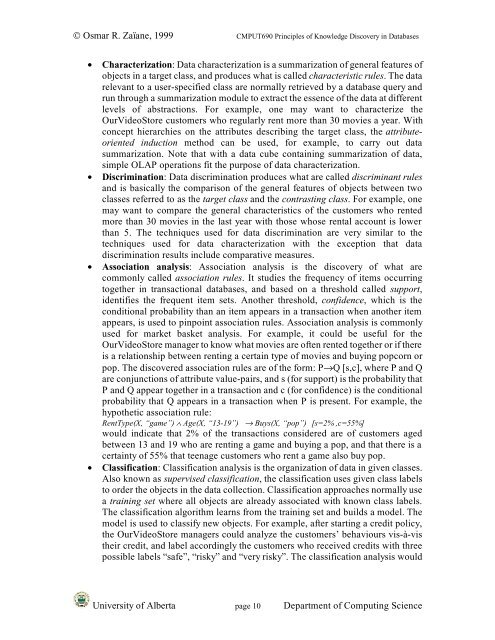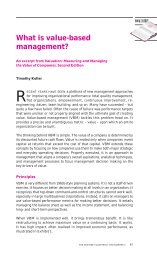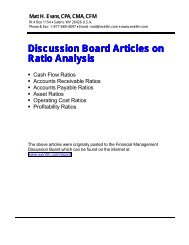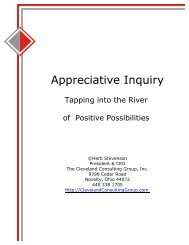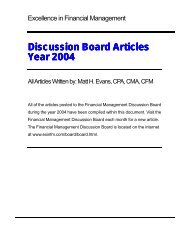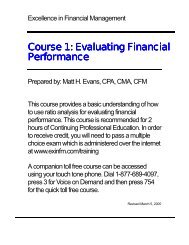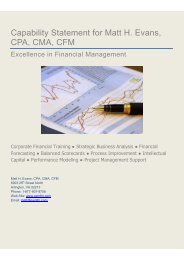Chapter I: Introduction to Data Mining
Chapter I: Introduction to Data Mining
Chapter I: Introduction to Data Mining
You also want an ePaper? Increase the reach of your titles
YUMPU automatically turns print PDFs into web optimized ePapers that Google loves.
© Osmar R. Zaïane, 1999 CMPUT690 Principles of Knowledge Discovery in <strong>Data</strong>bases<br />
• Characterization: <strong>Data</strong> characterization is a summarization of general features of<br />
objects in a target class, and produces what is called characteristic rules. The data<br />
relevant <strong>to</strong> a user-specified class are normally retrieved by a database query and<br />
run through a summarization module <strong>to</strong> extract the essence of the data at different<br />
levels of abstractions. For example, one may want <strong>to</strong> characterize the<br />
OurVideoS<strong>to</strong>re cus<strong>to</strong>mers who regularly rent more than 30 movies a year. With<br />
concept hierarchies on the attributes describing the target class, the attributeoriented<br />
induction method can be used, for example, <strong>to</strong> carry out data<br />
summarization. Note that with a data cube containing summarization of data,<br />
simple OLAP operations fit the purpose of data characterization.<br />
• Discrimination: <strong>Data</strong> discrimination produces what are called discriminant rules<br />
and is basically the comparison of the general features of objects between two<br />
classes referred <strong>to</strong> as the target class and the contrasting class. For example, one<br />
may want <strong>to</strong> compare the general characteristics of the cus<strong>to</strong>mers who rented<br />
more than 30 movies in the last year with those whose rental account is lower<br />
than 5. The techniques used for data discrimination are very similar <strong>to</strong> the<br />
techniques used for data characterization with the exception that data<br />
discrimination results include comparative measures.<br />
• Association analysis: Association analysis is the discovery of what are<br />
commonly called association rules. It studies the frequency of items occurring<br />
<strong>to</strong>gether in transactional databases, and based on a threshold called support,<br />
identifies the frequent item sets. Another threshold, confidence, which is the<br />
conditional probability than an item appears in a transaction when another item<br />
appears, is used <strong>to</strong> pinpoint association rules. Association analysis is commonly<br />
used for market basket analysis. For example, it could be useful for the<br />
OurVideoS<strong>to</strong>re manager <strong>to</strong> know what movies are often rented <strong>to</strong>gether or if there<br />
is a relationship between renting a certain type of movies and buying popcorn or<br />
pop. The discovered association rules are of the form: P→Q [s,c], where P and Q<br />
are conjunctions of attribute value-pairs, and s (for support) is the probability that<br />
P and Q appear <strong>to</strong>gether in a transaction and c (for confidence) is the conditional<br />
probability that Q appears in a transaction when P is present. For example, the<br />
hypothetic association rule:<br />
RentType(X, “game”) ∧ Age(X, “13-19”) → Buys(X, “pop”) [s=2% ,c=55%]<br />
would indicate that 2% of the transactions considered are of cus<strong>to</strong>mers aged<br />
between 13 and 19 who are renting a game and buying a pop, and that there is a<br />
certainty of 55% that teenage cus<strong>to</strong>mers who rent a game also buy pop.<br />
• Classification: Classification analysis is the organization of data in given classes.<br />
Also known as supervised classification, the classification uses given class labels<br />
<strong>to</strong> order the objects in the data collection. Classification approaches normally use<br />
a training set where all objects are already associated with known class labels.<br />
The classification algorithm learns from the training set and builds a model. The<br />
model is used <strong>to</strong> classify new objects. For example, after starting a credit policy,<br />
the OurVideoS<strong>to</strong>re managers could analyze the cus<strong>to</strong>mers’ behaviours vis-à-vis<br />
their credit, and label accordingly the cus<strong>to</strong>mers who received credits with three<br />
possible labels “safe”, “risky” and “very risky”. The classification analysis would<br />
University of Alberta page 10 Department of Computing Science


